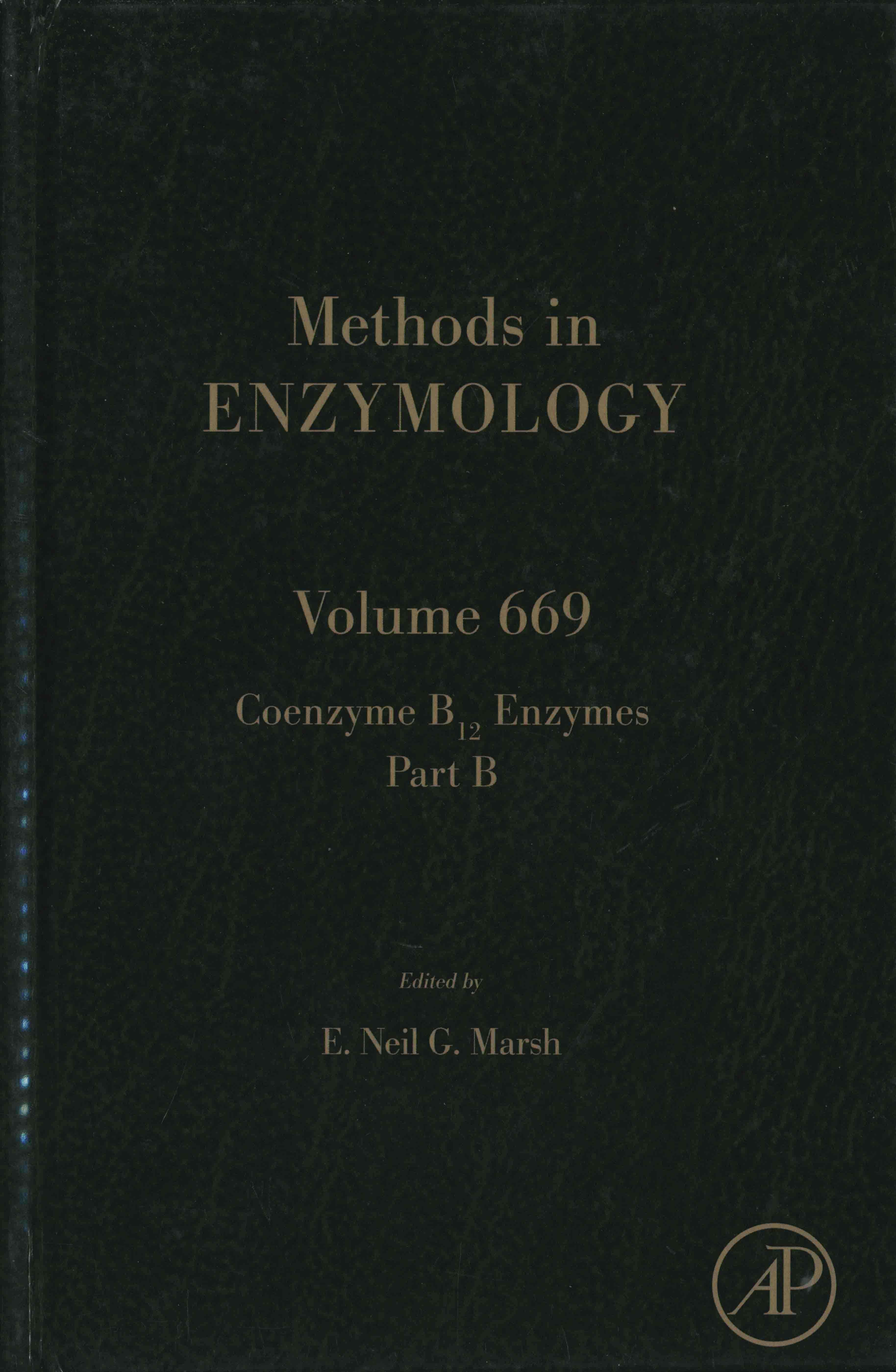 |
Coenzyme B12 enzymes. Part B / edited by E. Neil G. Marsh. -- Cambridge, MA : Academic Press, an imprint of Elsevier, 2022. – (58.17435/C719/v.669) |
Contents
Contributors
Preface
Section III
B12-dependent radical SAM enzymes
1. Structural characterization of cobalamin-dependent radical S-adenosylmethionine methylases
1. Introduction
2. Overproduction and purification of cobalamin-dependent radical SAM methylases
3. Protocols for crystallization and structure determination
4. Structure analysis
5. Conclusions
Acknowledgments
References
2. Purification and characterization of sequential cobalamin-dependent radical SAM methylases ThnK and TokK in carbapenem β-lactam antibiotic biosynthesis
1. Introduction
2. Heterologous expression and purification of ThnK and TokK
3. Time-course assays of ThnK and TokK
4. Conclusion
References
3. Characterization of the cobalamin-dependent radical S-adenosyl-L-methionine enzyme C-methyltransferase Fom3 in fosfomycin biosynthesis
1. Introduction
2. Heterologous expression and purification of Fom3
3. Enzymatic synthesis of HEP-CMP and HPP-CMP using the cytidyiyltransferase domain of Fom1
4. Elucidation of the true substrate and product of Fom3
5. Enzyme reaction of Fom3 using deuterium-labeled substrates
6. Perspective
Acknowledgments
References
4. Studies of GenK and OxsB, two B12-dependent radical SAM enzymes involved in natural product biosynthesis
1. Introduction
2. GenK catalyzes 6’-C methylation in gentamicin biosynthesis
3. OxsB and OxsA catalyzes ring contraction in oxetanocin A biosynthesis
4. Conclusion
Acknowledgment
References
5. Purification and structural elucidation of a cobalamin-dependent radical SAM enzyme
1. Introduction
2. Expression and purification of apo-OxsB
3. Crystallization of apo- and selenomethionine (SeMet)-labeled OxsB
4. Reconstitution of OxsB and crystallization of different cofactor-bound states
5. Lessons applicable to crystallography of other CBI-dependent radical SAM enzymes
6. Conclusions
Acknowledgments
References
Section IV
Methods for studying the mechanisms of B12 enzymes
6. Computational investigations of B12-dependent enzymatic reactions
1. Introduction
2. Computational approach
3. Model systems
4. Conclusions
References
7. Using kinetic isotope effects to probe the mechanism of adenosylcobalamin-dependent enzymes
1. Introduction
2. Methods
3. Using isotope effects to probe the mechanism of glutamate mutase
4. Conclusion
Acknowledgments
References
8. Steady-state and pre-steady state kinetic analysis of ornithine 4,5-aminomutase
1. Introduction
2. Steady state kinetic analysis of 4,5-OAM
3. Pre-steady-state kinetic analysis of 4,5-OAM
4. Conclusions
Acknowledgment
References
9. Exploring the mechanism of action of lysine 5,6-aminomutase using EPR and ENDOR spectroscopies
1. Introduction
2. Protocol for the preparation of protein samples for EPR and ENDOR measurements
3. Typical spectrometer settings for measurements of EPR and ENDOR spectra
4. Simulation protocol of EPR and ENDOR spectra
5. Tracking conformational movement
6. Identification and characterization of relevant radical intermediates
7. Conclusions
Acknowledgments
References
10. Resolution and characterization of contributions of select protein and coupled solvent configurational fluctuations to radical rearrangement catalysis in coenzyme B12-dependent ethanolamine ammonia-lyase
1. Introduction
2. Protein dynamics and contributions to enzyme catalysis: Definitions and concepts
3. Revealing contributions of select protein configurational dynamics to enzyme catalysis under ensemble conditions
4. Sample preparation and measurement of reaction kinetics
5. Temperature-dependence of substrate radical decay reaction in ethanolamine ammonia-lyase
6. Interpretation: Contributions of select protein configurational dynamics to EAL enzyme catalysis
7. Role of solvent coupling in select protein configurational dynamics
8. Conclusions
Acknowledgments
References
11. Investigating radical pair reaction dynamics of B12 coenzymes 1: Transient absorption spectroscopy and magnetic field effects
1. Introduction
2. Materials, equipment and reagents
3. Method details: Instrumental setup and sample preparation
4. Step-by-step protocol: Measuring MFEs on the ultrafast photochemical dynamics of AdoCbl
5. Data analysis
6. Advantages and limitations
7. Summary
Acknowledgments
References
12. Investigating radical pair reaction dynamics of B12 coenzymes 2: Time-resolved electron paramagnetic resonance spectroscopy
1. Introduction
2. Equipment, materials and reagents
3. Method details: Instrumental setup and sample preparation
4. Step-by-step protocol: Measuring MeCbl RP dynamics using TREPR
5. Assembly and analysis of the TREPR spectra
6. Advantages and limitations
7. Optimization and troubleshooting
8. Summary
Acknowledgments
References
13. Time-resolved spectroscopy: Advances in understanding the electronic structure and dynamics of cobalamins
1. Introduction
2. Sample delivery
3. Polarization dependence
4. Power
5. Kinetics description of photoexcited cobalamins
6. Comparison of theory and experiment
Acknowledgments
References
14. Electronic structure studies of free and enzyme-bound B12 species by magnetic circular dichroism and complementary spectroscopic techniques
1. Overview
2. Spectroscopic studies of free B12 species
3. Application of MCD spectroscopy to the study of enzyme-bound B12 species
4. Reductive dehalogenases
Acknowledgments
References